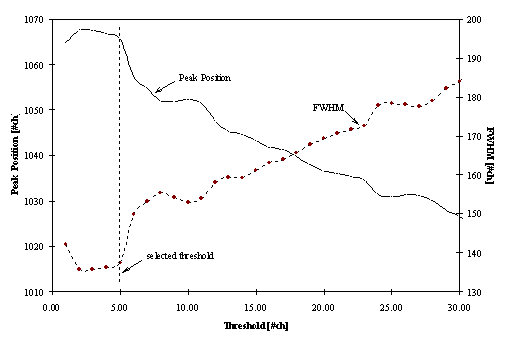 ,
,





Experience from earlier beam periods [Bro96] showed that there occurs coherent noise between calorimeter channels (and among other modules, as well). Possible sources of common noise are induced currents in flat ribbon cables, commonly used NIM and CAMAC modules or patch panels. The on-line pedestal information was used in the common subtraction of that noise. For this `secondary pedestal subtraction'(SPS) the minimum value of an ADC entry was evaluated. (This was done separately for the combined modules, as there are the CsI-array, the Hodoscope strips and the NaI-wall.) Then the average secondary pedestal position of all channels not exceeding 10 ADC channel numbers (20 for the NaI) above the minimum was computed and subtracted from all ADC values.
Rather than using all channels of a detector, a division into subgroups was more suitable. For a reliable common noise suppression the correlation coefficient r between two channels at a time was calculated using
 ,
,where N is the number of entries under the pedestal peak and xi and yi, the i-th pedestal entries for crystals x and y, respectively. Since this led to some ambiguous results, the idea to group together all channels with high r was not feasible. Instead, initially groups of 16 were generated because of the fact that a LeCroy Fastbus ADC holds 5 groups of 16 channels. Then members of these groups with a poor r concerning other group members or with suspicious looking pedestal peaks (double peaks for instance) were excluded. For those channels the correlation coefficient r helped again to find the appropriate members to group with. The minimum number of members in a group was set to six. Too few members in a group do not allow reliable SPS anymore, since no average common noise level could be calculated if all members of a group had reported a valid hit.
After applying SPS, the average noise contribution to the CsI-array was 0.1±1.44 ch. (4 ± 62 keV) and for the NaI-wall -0.31±4.23 ch. (13 ± 179 keV). The higher noise level for the NaI channel results from a wider ADC-gate due to the slower decay time of the scintillation light. (Those values were also implemented in the GEANT simulation.)
With these pedestals the necessary noise threshold was established, needed for energy summing and gain calibration. To this end the peak position of the sum of all CsI-modules exposed to 70 MeV positrons was plotted against the noise threshold; the secondary axis of Figure 7-2 shows the same for the FWHM. Theoretically the value of the peak position should reach a plateau as soon as the threshold value excludes fluctuations due to noise. When low energy contribution becomes excluded, the peak-position will drop continuously.

A distinct maximum for the peak-position was found at a threshold of 3 channels, where the peak width also is at minimum, which corresponds to 2 s of the averaged noise peak. To be on the safe side a threshold of 3.5 s was chosen which leads to 5 channel numbers for the CsI and 15 for the NaI. Additionally, individual thresholds were implemented for each channel, but no further improvement could be reached.





